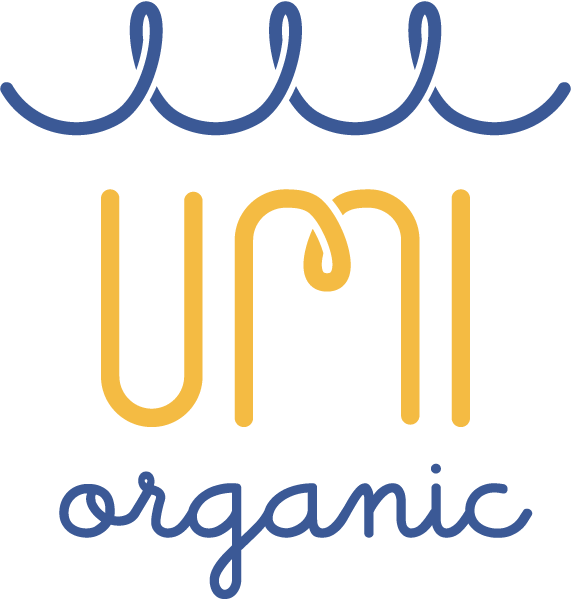This recipe is inspired by the wonderful Japanese classic agedashi tofu, but takes it in the direction of a teriyaki dish, coating the lightly fried tofu pieces in our Umi Organic yakisoba sauce. The tofu is not at all greasy—one of the miracles of this cooking technique. This is very easy to make and a textural treat. I like keeping the tofu pieces large so you get to enjoy their contrasting textures after frying. I typically eat this over rice but it would be great over Umi noodles in a miso sesame sauce.
The year I lived in Kyoto, Japan, I traveled to Korea over winter break. On Christmas morning, in the freezing cold, I was walking to catch a bus and came upon a street food vendor making breakfast sandwiches. The snow had begun to fall and he let me shelter under his tarp while he made me a very simple cabbage-egg omelet that he served between big fluffy slices of white bread with a delicious sauce that reminded me of Japanese okonomiyaki sauce. I loved the sandwich so much! It felt vaguely healthy but also rich and satisfying. When we made our own yakisoba sauce, with some of those same flavor notes, I knew I wanted to try to recreate this breakfast sandwich.
Pan-frying whole chicken thighs briefly, then steaming them with a little sake, and finishing with our Umi yakisoba sauce makes the most succulent and delicious teriyaki-style chicken. It’s also incredibly easy to make and goes with any side dishes you’d like! It’s not a typical teriyaki because our sauce has a more complex, umami-rich sweet-and-sour flavor thanks to Worcestershire, tamarind, and apple puree, but it’s definitely in the same family and scratches the same itch!
I find mushrooms spectacularly delicious and satisfying. This dish highlights shiitake mushrooms—every single bite of noodles is tangled with a few mushrooms, which means every bite is a winner. While this recipe calls for shiitake, any number of mushrooms would work well in their place: oysters, criminis, lobsters, chanterelles—any mushrooms that tastes good sautéed in oil. This is now my favorite way to eat yakisoba noodles!
“I love the versatility of yakisoba. When I was growing up, my mom prepared yakisoba using pork, carrots, cabbage, onions, and bean sprouts. Since I live in Portland where we have access to a wide variety of vegetables on a year-round basis, I use whatever seasonal vegetables I have on hand for my yakisoba. I always aim for at least 5 colors in all of my meals and yakisoba makes it easy to achieve my goal.”
Yakisoba-pan was born in the 1950s, at the equivalent of a Japanese diner where bread had become a common yakisoba side dish to sop up the rich, glistening sauce. It takes the chewy savory noodles and tucks them into a milk bun known as koppe-pan that looks deceptively like a hotdog bun. Jane Hashimawari of Ippaipdx shared her recipes for one of the greatest after-school snacks of all time!
Traditionally, yakisoba would be served with cabbage, but Brussels are a great replacement, offering their own distinct flavor and vivid color. Because you're shredding the Brussels sprouts, there's no need to core them. My secret is to simply use the Cuisinart shredder. I pop the Brussels in one by one and save myself all the work of cutting. This recipe is a riff on one our dear friend Jane Hashimawari of Ippai PDX shared with us. I almost always top with a bit of Kewpie mayonnaise because it takes it to 100.
Naomi Molstrom, our go-to favorite noodle lover and adviser (who claims her body is 90% comprised of noodles!), shared one of her recipes for yakisoba at home. This takes minutes and is hand’s down delicious! She makes this for lunch for herself and her two sons on the regular.
This popular Japanese street food is the most hearty, lip-smacking cabbage pancake you could dream up, with layers of pork belly, crispy noodles, and a fried egg. It's a show stopper.










I was delighted when I experimented by using our Organic Yakisoba Sauce in place of classic Otafuku or Bulldog Okonomiyaki Sauce. It works like a dream! In fact, I insist: try it out! It’s so special!
In the Kansai region, where okonomiyaki was invented and where I lived (Kyoto, Osaka, and Kobe are all within Kansai), the ingredients are all mixed together and cooked as one mass. Many regions have their own adaptations—the other most famous style comes from Hiroshima—but the Kansai version is the easiest to make. I like to eat this with rice and miso soup.